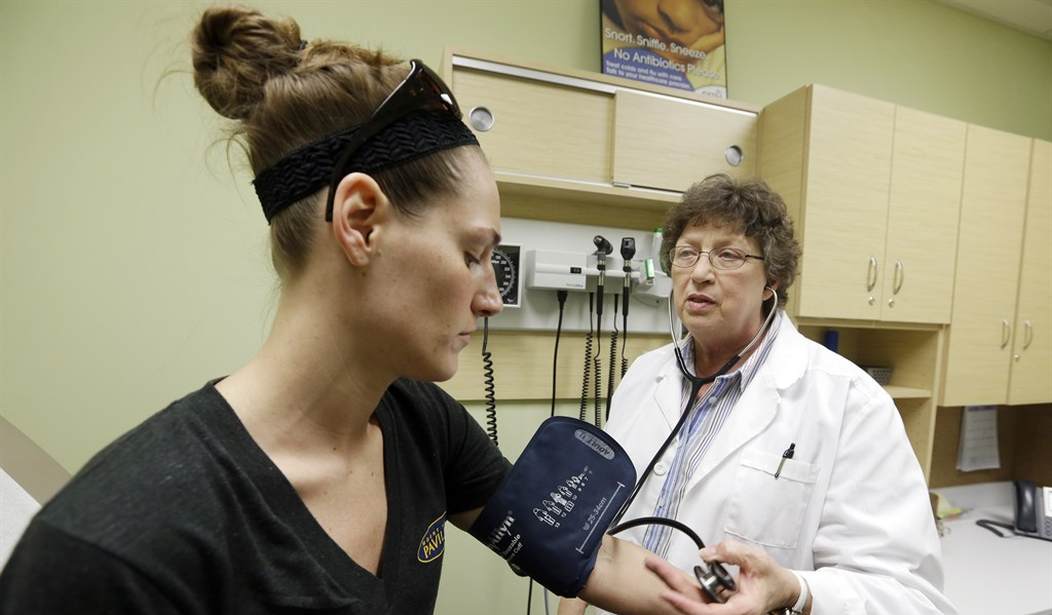In the September issue of Townhall magazine, where this column originally appeared, Townhall Finance's John Ransom explains how concierge medicine saved his life.
Get more done with less.
That’s part of the problem with Obamacare.
In its haste to pass a health care “reform” bill that wouldn’t sacrifice quality, the Democrats inserted language that commits medical providers to certain levels of care while trying to hold down costs. And that commitment strains the most important resource that doctors have: their time.
As new physicians choose to avoid primary care as their specialty, the average workload of doctors on the frontlines is growing. With an estimated 2,500 patients per doctor, a report by the Annals of Family Medicine says that a doctor would have to spend 21.7 hours per day to implement all of the recommended treatments and procedures for a typical practice. And that is just for acute care patients.
“On the other hand,” write the authors of the report, “the decreasing number of physicians entering adult primary care, in part due to the excessive work of primary care physicians, which dissuades US medical students and residents from choosing primary care careers, means that [the number of patients] will increase, particularly as more people have insurance coverage and seek access to a primary care medical home.”
Recommended
Increasingly primary care physicians already in practice are leaving behind the traditional insurance-based model of primary care for what is known as concierge medicine, where for a flat monthly fee, patients get access to their doctor 24 hours a day, seven days a week. And appointments last 45 minutes to an hour with a doctor, not a nurse practitioner.
The model allows doctors to manage a practice of 300-600 patients, who each pay around $1500-$2500 per year additionally, rather than the thousands necessary under an insurance framework. And the long appointments give doctors the time for the preventive care that is currently missing in the system.
I’m a fan of the system.
Not only do I know it works; it likely saved my life.
After several years of declining health, rapid weight gain, and blood pressure that was out of control, I picked up a brochure in my doctor’s office that explains how concierge medicine works.
My interest at that time was to find out more about the concept because I thought they’d make a great sponsor for my radio show, or as a free-market solution to health care, which undoubtedly is broken in the country. I had no idea that it could somehow help me beyond buying 30-second spots for radio.
On a subsequent visit I asked the doctor about it, again, to prospect for a sponsor. She promptly signed me up.
A comprehensive appointment was scheduled, which lasted an hour with the doctor, blood was drawn, and the physician’s assistant logged a long list of past and present ailments. By the end of my first appointment I knew that I had Hashimoto’s disease, a fairly common autoimmune disease that attacks the thyroid. My thyroid was low, sub-clinical, and I was put on a supplement.
A previous doctor in passing told me that my thyroid was a little low, and supplements were recommended. But this time was different. This time the physician took the time to explain how the other ailments I complained of could be the result of a low thyroid.
Six months later, after taking an inexpensive supplement, I had lost 50 pounds, my waist went from a 38 to a 32, my blood pressure was reaching normal levels, and I was about to turn 50 years old. People asked me how I felt. I told them that I felt like I was 18 again, but that I never felt this good at age 18.
If ever there was a best practice definition of health care, it was just practiced on me first-hand. But instead of being able to preach about it, my physician modestly asked me not to mention her name publicly in regards to concierge medicine.
Yes, I can’t mention the doctor or the practice that was responsible for this miracle of modern medicine. The insurance companies and the Obama administration don’t like this type of thing, as I understand it. I mean after all, where would all of our wonderful socioeconomic progress be if great health, made possible by a cheap supplement, were allowed to reform medicine on its own? There would hardly be a need for government intervention at all.
When the Democrats reformed health care, stakeholders from many areas talked about a lot of things. But they didn’t mention the things important to doctors and patients. They didn’t mention the broken bones, the common colds, the strained muscles, or the low thyroid conditions that bring patients and doctors together.
And there is one other thing they forgot to mention, but they aren’t the only ones.
The aforementioned reported recommends that to give patients more quality care, a more “team-centered” approach be taken to medicine, with tasks assigned to someone other than a physician.
“Solving the primary care dilemma—excessive [patient numbers] in an environment of a primary care physician shortage—requires the replacement of physician-only care with team-based care,” concludes the report. “Such an unprecedented change in both the culture and structure of primary care practice can be accomplished only through a change in clinician mindset, the training of nonclinician team members, the mapping of workflows and tasks, the creation of standing orders that empower nonclinicians to share the care, the education of patients about team-based care, and the reform of primary care payment.”
Or they could just reform the system so that both the doctor and the patient have more time together, ensuring quality care and doctor job satisfaction.
Yeah, I know: That’s just crazy.

























Join the conversation as a VIP Member